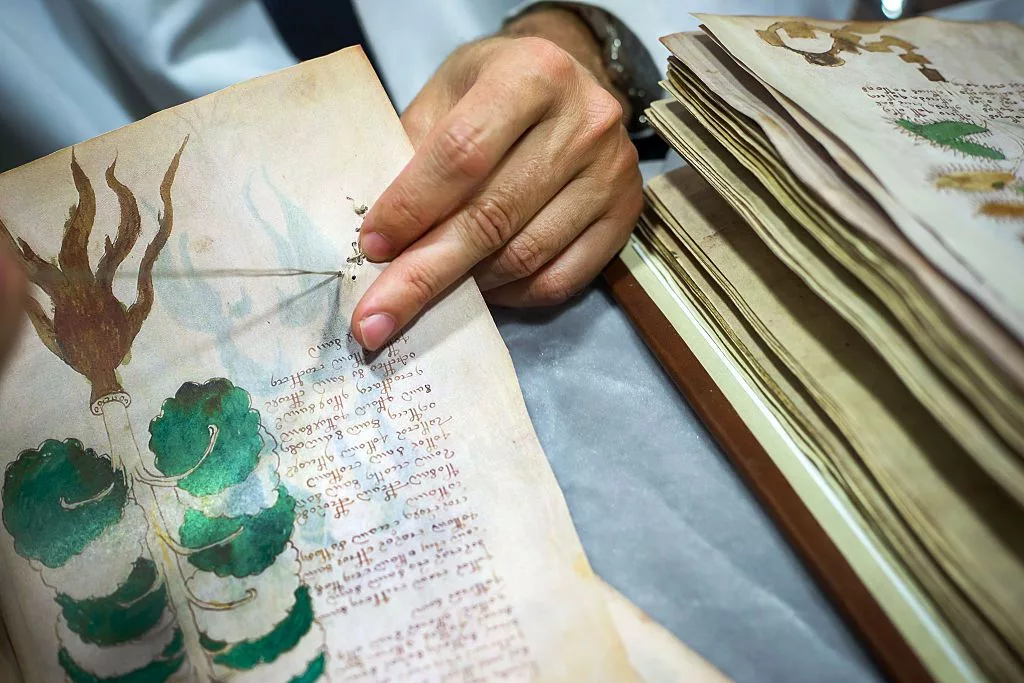The Voynich Manuscript is often hailed as the world’s most enigmatic book. Discovered in 1912 by rare book dealer Wilfrid Voynich, this manuscript has baffled linguists, cryptographers, and historians for over a century. Written in an unknown script and filled with strange, colorful illustrations of plants, astronomical diagrams, and nude figures, the manuscript seems to defy all attempts at decipherment. Scholars have debated its origins, purpose, and meaning, and despite numerous theories, the Voynich Manuscript remains a tantalizing mystery.
More than just an ancient artifact, the Voynich Manuscript embodies the human drive to explore the unknown. Its pages have captured the imagination of experts and enthusiasts alike, making it a unique symbol of mystery that transcends time. What makes this book so compelling is not just its impenetrable script but the sheer depth of its artistry and the questions it raises about our ancestors’ understanding of the world. This enigmatic text forces us to confront the limits of our knowledge and reminds us that there are still profound puzzles left to solve in the realms of history and language. Each attempt to unravel its mysteries serves as a testament to humanity’s endless curiosity and determination.
The Discovery of the Voynich Manuscript
The manuscript came to light in 1912 when Wilfrid Voynich acquired it from a Jesuit library at Villa Mondragone in Frascati, Italy. Bound in parchment and containing 240 surviving pages (with evidence of missing leaves), the manuscript was unlike anything Voynich had seen before. Its text was written in an unknown alphabet, and its illustrations featured bizarre plants, unfamiliar celestial charts, and human figures engaged in mysterious activities. Recognizing its potential importance, Voynich brought the manuscript to the attention of scholars, who were immediately intrigued by its cryptic nature.
Dating of the manuscript’s vellum places its creation in the early 15th century, around the 1400s. While it is unclear who authored it, ownership records hint at a fascinating journey through history. The earliest known owner is believed to be Holy Roman Emperor Rudolf II, who supposedly purchased it in the late 16th century for a substantial sum. The manuscript later passed through the hands of various scholars, including 17th-century alchemist Georg Baresch and Jesuit scholar Athanasius Kircher, before it was acquired by Voynich. Despite these clues, the identity of its author and the purpose of its creation remain shrouded in mystery.
The manuscript’s mysterious provenance only adds to its allure. How did it survive centuries of upheaval? What prompted its creators to write in an undecipherable language? These questions have only deepened the intrigue, leading to countless theories and debates among historians and cryptographers. The manuscript seems to occupy a space between science, art, and mysticism, defying easy categorization and keeping its secrets close. Each layer of its history reveals a new thread of fascination, weaving together a story as enigmatic as the manuscript itself.
The Content of the Voynich Manuscript
The Voynich Manuscript is divided into distinct sections based on its illustrations, which appear to correspond to different themes. While the text is written in an undeciphered script now referred to as “Voynichese,” the illustrations provide some context for the manuscript’s content. Each section reveals a different facet of its creators’ mysterious intentions, blending practical knowledge with abstract imagery, challenging modern interpretations while tantalizing us with glimpses of a lost worldview.
The Herbal Section
One of the largest sections of the manuscript features drawings of plants, many of which are unrecognizable to modern botanists. These illustrations are accompanied by text, which some researchers speculate might describe the plants’ medicinal uses, preparation methods, or symbolic meanings. However, without a readable text, these hypotheses remain speculative. The combination of fantastical and semi-realistic plant depictions has led some to suggest that the manuscript represents a blend of real-world botanical knowledge and imaginative invention.
This section has sparked debates about whether the plants depicted are entirely fictional or based on species known at the time. Some researchers argue that the drawings may represent a kind of “coded” botanical knowledge—perhaps an attempt to keep valuable medicinal information secret. Others suggest that the images might be symbolic rather than literal, representing spiritual or metaphysical concepts tied to the plants. The vivid illustrations and careful detail suggest a deep reverence for the natural world, possibly linking the plants to healing practices, religious beliefs, or both.
The Astronomical and Cosmological Section
This section includes intricate circular diagrams that appear to depict celestial phenomena, including zodiac symbols and what could be star charts. Some illustrations also feature nude female figures interacting with what look like interconnected tubes or vessels, possibly representing constellations or natural cycles. This imagery has been interpreted as a representation of astronomical or cosmological knowledge, although its exact purpose remains unclear.
The celestial diagrams have intrigued astronomers and historians alike. Could they represent an early understanding of the cosmos? Or are they purely symbolic, reflecting mystical beliefs rather than scientific observations? The recurring presence of zodiac signs suggests a connection to astrological practices, which were deeply intertwined with medicine and spirituality in medieval times. Yet, without a clear key to the text, the true meaning of these diagrams remains elusive. Some theories propose that the diagrams may also map seasonal changes or agricultural cycles, hinting at their practical use in daily life as well as their symbolic significance.
The Biological Section
The manuscript’s biological section is perhaps its most puzzling. It contains depictions of human figures, mostly women, in various poses and scenarios, often interacting with flowing liquids or immersed in pools connected by strange, organic structures. Some scholars believe this section could symbolize alchemical processes or medical practices, while others think it may represent metaphysical or spiritual concepts. The lack of any clear textual explanation deepens the mystery.
The imagery in this section has been likened to medieval depictions of the body’s humors or early attempts to map biological processes. The flowing liquids and interconnected structures might symbolize life cycles, fertility, or even healing rituals. Alternatively, they could represent abstract philosophical ideas about the interconnectedness of life and the cosmos, offering a glimpse into the worldview of its creators. The recurring motifs of water and interconnectedness suggest a fascination with the fluidity of life itself, whether interpreted literally or symbolically.
The Pharmacological and Recipes Section
Toward the end of the manuscript, there are pages with labeled plant parts, containers, and objects that resemble apothecary tools. These are often grouped together in ways that suggest a pharmacological purpose, possibly detailing remedies or recipes. Without a key to the text, however, any interpretation remains purely hypothetical.
This section reinforces the theory that the manuscript may have served as a compendium of medicinal knowledge. The inclusion of tools and containers suggests a practical application, perhaps as a guide for preparing herbal remedies or conducting alchemical experiments. However, the cryptic nature of the text leaves open the possibility that this section could also have symbolic or ritualistic significance. The meticulous organization of these pages hints at an intent to preserve knowledge, whether for practical, spiritual, or enigmatic purposes.
Theories About the Voynich Manuscript
Over the decades, countless theories have been proposed to explain the Voynich Manuscript. From a genuine work of forgotten knowledge to an elaborate hoax, opinions vary widely. Here are some of the most prominent theories:
A Medieval Medical or Herbal Text
One popular theory posits that the manuscript is a medical or herbal text, created as a compendium of botanical and pharmacological knowledge. The detailed plant illustrations and references to liquids and containers support this idea. It is possible that the script represents a cipher or an obscure language intended to protect proprietary knowledge or keep the text accessible only to a select group. If true, the manuscript could be a glimpse into medieval science, offering insights into early medicine and botany.
An Alchemical or Esoteric Work
Others believe that the Voynich Manuscript is an alchemical or esoteric text, designed to convey spiritual or mystical knowledge. The astronomical diagrams and symbolic imagery align with the traditions of alchemy and the occult, which often used coded language and complex symbols to obscure their teachings from outsiders. The manuscript’s mysterious script could reflect this tradition of secrecy, making it a repository of hidden wisdom meant for a select few.
A Hoax or Artistic Experiment
Some skeptics argue that the manuscript is an elaborate hoax or artistic experiment with no real meaning. According to this theory, the text could have been created as an intellectual challenge or as a way to fool a wealthy patron, such as Rudolf II. The consistent structure of the script, however, suggests a degree of coherence that makes this theory less likely. If it is a hoax, it is one of unparalleled complexity and dedication.
A Lost Language or Cipher
Perhaps the most tantalizing possibility is that the Voynich Manuscript is written in a lost language or an unbroken cipher. If this is true, cracking its code could unlock a treasure trove of historical, scientific, or cultural knowledge. Efforts to decode the text using modern computational tools and linguistic analysis have so far yielded inconclusive results, but advancements in technology could one day provide the key to understanding the manuscript. This theory keeps hope alive that the manuscript may hold secrets waiting to be unveiled.
Efforts to Decipher the Voynich Manuscript
Over the years, the Voynich Manuscript has attracted the attention of some of the world’s greatest cryptographers, linguists, and computer scientists. During World War II, experts who successfully cracked enemy codes attempted to decipher the manuscript but failed. In recent decades, artificial intelligence and machine learning have been employed to analyze patterns in the text, yet no definitive breakthrough has been made.
One challenge in deciphering the manuscript is determining whether “Voynichese” represents a real language, a cipher, or an entirely invented system. Statistical analyses have revealed patterns in the text that resemble those found in natural languages, but the lack of a Rosetta Stone or key has made progress slow. Even so, researchers remain hopeful that future innovations will eventually unravel the manuscript’s secrets. Each attempt at decipherment brings new tools and perspectives, inching closer to what could be a historic revelation.
The Enduring Mystery of the Voynich Manuscript
The Voynich Manuscript is more than just an unsolved puzzle; it is a testament to humanity’s curiosity and ingenuity. Its cryptic allure has drawn generations of researchers, each driven by the hope of unlocking its secrets. Whether it is a repository of forgotten knowledge, an artistic masterpiece, or a complex hoax, the manuscript continues to inspire wonder and debate.
For now, the Voynich Manuscript remains a riddle without an answer, a challenge that transcends time and discipline. As technology advances and new methodologies emerge, perhaps one day we will finally decode its meaning. Until then, it stands as a beacon of the unknown, an enduring reminder of how much we still have to learn about the past. Its pages continue to captivate and perplex, offering a glimpse into the creativity, intellect, and ambition of its enigmatic creators. The Voynich Manuscript invites us to dream, to question, and to push the boundaries of what we know. While its meaning remains elusive, the very pursuit of understanding it reflects the unyielding human spirit of discovery. As researchers persist and technology evolves, this enigmatic artifact may one day share its secrets, but until that time, it remains one of history’s most fascinating and unsolved mysteries.




